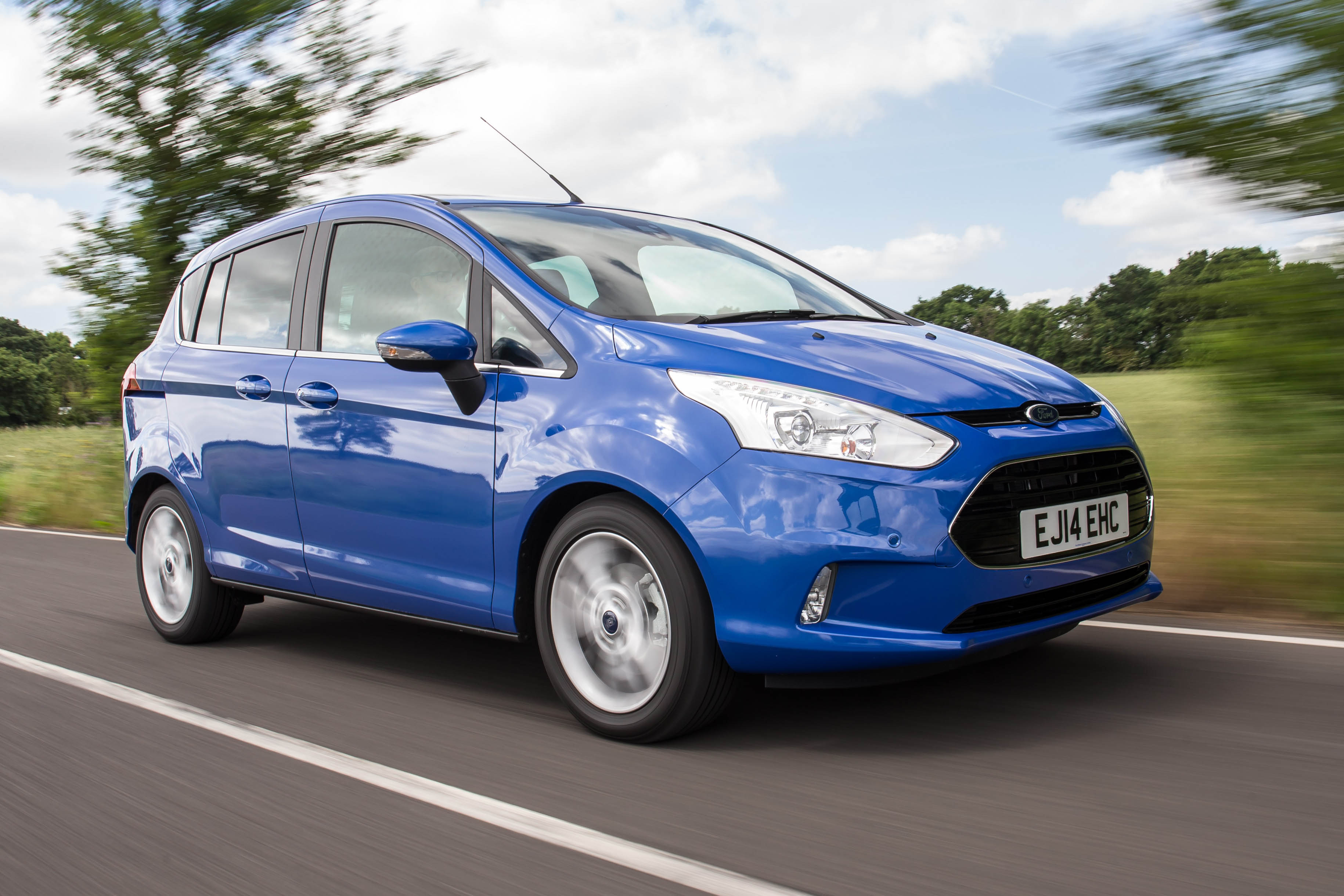Ford B-MAX (2012-2017) Review
Written by Andrew Brady
Quick overview
Pros
- Clever doors add to big practicality
- Fun to drive
- Good specification and engine range
Cons
- Firm ride might not suit all
- Won’t win any beauty contests
- Entry-level petrol engines are best avoided
Overall verdict on the Ford B-MAX
"Ford’s MPV expertise was evident in the B-MAX, which was impressively practical for a car so small. It didn't skimp on the driving experience either, and with its good specification and low running costs, there's still a lot to like about it."
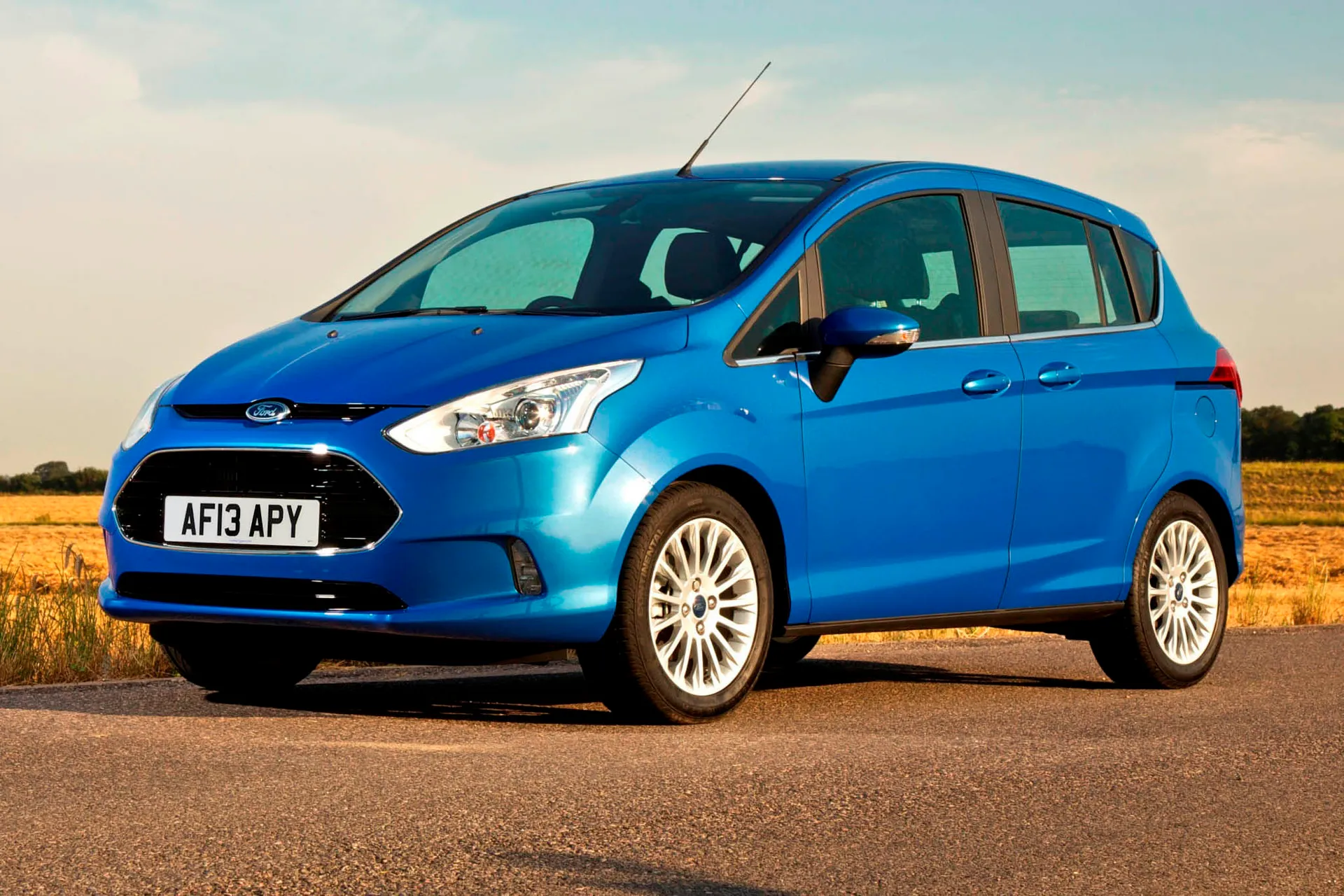
The MPV revolution seems like a lifetime ago - now most people flock towards bulky SUVs if they want something big and vaguely practical - but a decade ago people carriers of all shapes and sizes were still the favoured solution for getting your kids in the car without blowing a fuse. With successful models like the Galaxy, C-MAX and S-MAX already in the range, it made sense for Ford to downsize to the max, spinning a five-seat MPV off the bones of the Fiesta to create the Ford B-MAX. Let's take a closer look with our Ford B-MAX review.
While the Ford B-MAX was never going to be able to carry seven people, Ford managed to boost the practicality of its small MPV by installing a pair of sliding rear doors. Better yet, it went one further and did away with the B-pillar - the vertical beam you normally get between the front and rear doors - by incorporating strengthening into the doors themselves, leaving a huge aperture that made it a breeze to get into the rear seats.
There were further upsides to the Ford B-MAX being based on the Fiesta too. The engine range was wider than you get with most cars, with a choice of four petrols and two diesel versions depending on the model year, a PowerShift automatic gearbox was available too. Pick of the bunch were the two tiny 1.0-litre EcoBoost petrols - they may have only had three cylinders but they punched well above their weight and made the Ford B-MAX more fun to drive than expected - they were also frugal.
The rest of the driving experience was similarly impressive. Ford had been imbuing all its cars with the fundamentals of a good driving experience for decades, and the B-MAX was no different. Just like its Fiesta sibling, it had sharp and reactive steering and well-sorted suspension that kept it composed, helping the driver stay in touch with the road. You might not have intended to hurl your Ford B-MAX down a country road on the way home from school, but a car that steers and rides with confidence is always preferable to one that doesn’t.
Inside, there were more carryover components from the Fiesta, which was somewhat less of a positive. Much of the dashboard, controls and instruments were ported straight across, and while familiarity was usually a good thing, it was not perfect. Some of the materials felt a little on the cheap side - if likely to be hard-wearing - and if you went for a higher-spec model, the sheer number of buttons in front of you could be a little confusing. Practicality was strong though, helped by those smart rear doors, and it made the most of its footprint with plenty of storage and sensible features.
The Ford B-MAX also represented good value and still does. Production ended in 2017 but there are plenty of examples out on the road, with the cheapest nearing the £1,500 mark. In particular, the Zetec models make the most sense, giving you the widest choice of engines and a good specification. It was also the most popular trim, so you should find lots to choose from.
Looking for a used car for sale? We've got 100s of Ford Approved Used Cars for Sale for you to choose from, including a wide range of Ford B-Max cars for sale.
Is the Ford B-MAX right for you?
If you needed to carry a lot of stuff and/or people on a regular basis but wanted to do so in a small car, your choices were relatively limited. The B-MAX made an excellent case for itself though. It was a practical car even before taking into consideration the sliding rear doors, and if you regularly had people getting in and out of the back seats - or even using the space as a makeshift van - you’d wonder how you lived without it.
It also drove well enough and didn't feel like a compromise, although if you could live with a conventional Fiesta you would've saved yourself some money and had a car that was easier to sell afterwards.
What's the best Ford B-MAX model/engine to choose?
The 75PS is best avoided. It may have had a useful 190Nm of torque but it was comfortably the slowest Ford B-MAX on sale. If a diesel is really needed, go for the 95PS version.
Devil's fuel aside, we'd recommend one of the two EcoBoost units. These offer a tasty blend of performance and economy.
What other cars are similar to the Ford B-MAX?
Just like the old days, the main rival to Ford came from Vauxhall in the shape of the now-discontinued Meriva. The most recent version arrived a couple of years before the Ford B-MAX in 2010 and had its own take on better access to the rear seats with a pair of ‘suicide’ doors - hinged from the rear rather than the front. Today, the closest thing would be a Dacia Jogger or Citroen Berlingo.
Pigeonholed as a small hatchback rather than an MPV, Honda’s Jazz is almost somewhere between the two. The new version is impressive and has a small footprint, a tall body and impressive space efficiency. It remains the sensible compromise if you don’t want a full MPV experience. If you want something more utilitarian, look at Ford's own Tourneo Connect.
Comfort and design: Ford B-MAX interior
"It should be fairly easy to get comfortable in the Ford B-MAX. The steering wheel had a large range of adjustment and the same goes for the seats, so it was easy to find a comfortable driving position."
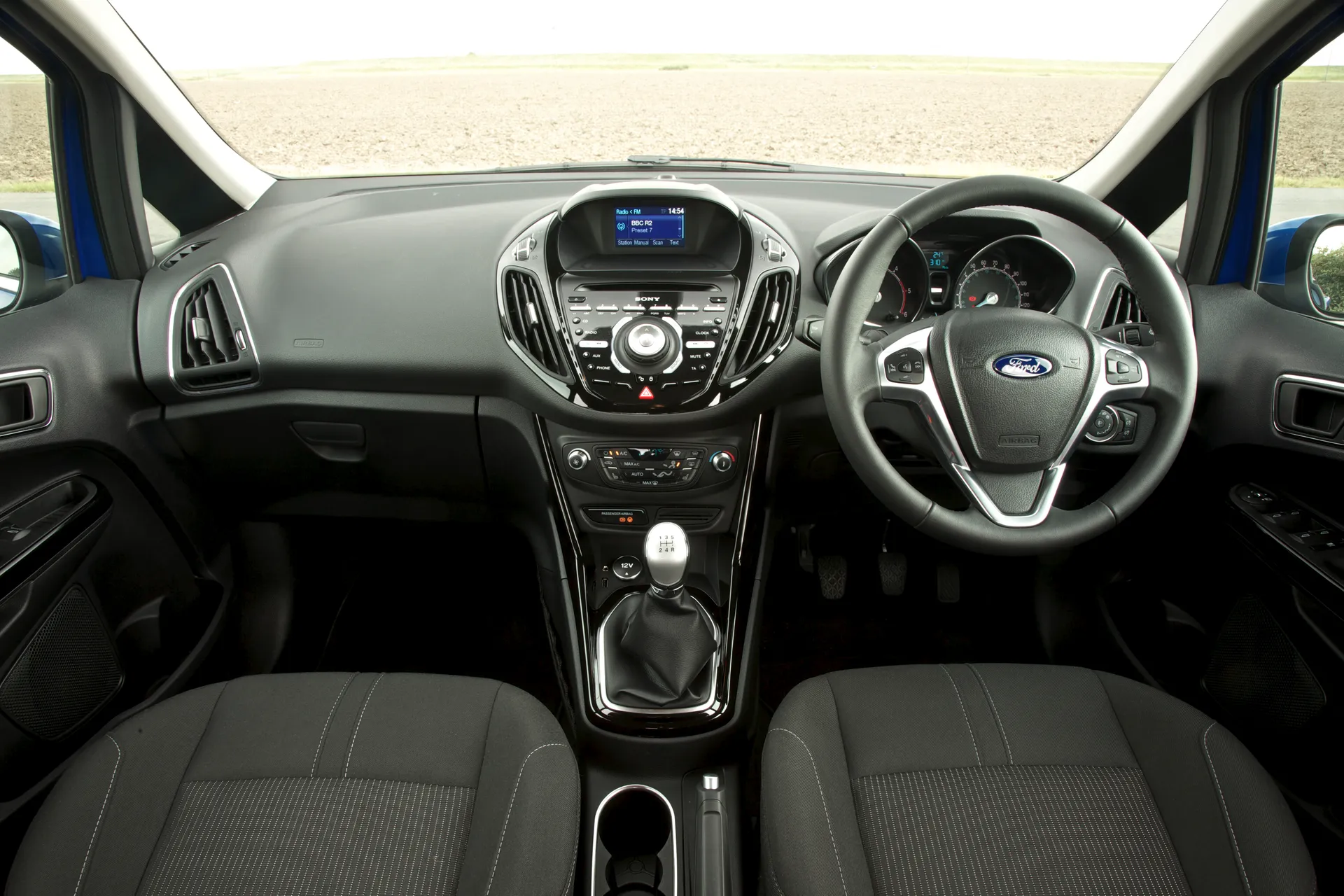
It presented you with a good view out too - the side windows of the Ford B-MAX sloped downwards towards the front of the car and the windscreen was big too, all of which helped the feeling of comfort and being in command of the car.
The seats themselves offered good support for the vast majority of drivers. It’s worth noting that because there’s no B-pillar, the seat belts in the front are mounted on the outside of the seat themselves, which actually brings them a little bit closer to the occupant. There were also three seat belts across the rear, although the centre seat was slightly slimmer than the two outside seats.
The cabin layout owed a great deal to the Fiesta on which the Ford B-MAX is based, which was both a good and bad thing. It’s good because you’ve probably ridden in a Fiesta before so it'll feel familiar, and the relatively high-set dashboard meant everything was close to the driver. The downside was that the button and control layout did seem a little scattergun.
Whichever level of infotainment system you opted for with the Ford B-MAX, there were many small buttons to fathom. It worked well enough, but until you were familiar with the layout you didn't want to be trying to find a button in a hurry.
Quality and finish
Broadly speaking, the cabin of the Ford B-MAX was built to last rather than to wow. Again, much of the fitments were carried over from the Fiesta, which wasn't necessarily bad, but was a reminder that this MPV was a grown-up small car rather than anything fancier.
Opting for the basic Studio trim level got you a plastic and cloth finish, which were hard-wearing if not necessarily appealing to the eye, but on Zetec and Titanium, you got part fake leather on the seats and real leather on the steering wheel and gear lever, which at least meant your main contact points were pleasing to the touch. The Ford B-MAX in Titanium X trim turned the fake leather into the real thing but was still only a part finish.
Infotainment: Touchscreen, USB, sat-nav and stereo in the Ford B-MAX
The basic infotainment on the entry-level Ford B-MAX Studio wasn't as bad as expected. You got a radio/CD including DAB and USB input, so you could at least listen to your choice of music. What was less impressive was the physical layout of the system, which was clearly early-2008 Fiesta. Designed to resemble mobile phones of the period, it packed dozens of buttons into a relatively small space, while the screen itself was a relatively small five inches.
Ford B-MAX Zetec models had the same basic layout but with the addition of Ford SYNC, which meant a Bluetooth hook-up for streaming music and making phone calls, with the option to use voice control or steering wheel controls. Ford B-MAX Titanium and Titanium X models offered a further upgrade with a Sony audio system which brought better sound quality and an extra pair of speakers (eight in total), although even this setup suffered from having too many small buttons.
Later B-MAX models came in Navigation-spec, available in Zetec, Titanium and Titanium X trim, which as the name suggests, added sat-nav as standard. With the B-MAX being too early for screen mirroring, it was either this system or relying entirely on your mobile phone if you wanted navigation.
Space and practicality: Ford B-MAX boot space
Choosing the Ford B-MAX meant space efficiency and practicality were a priority, and the little Ford delivered all you could reasonably expect from a car this size (the Ford B-MAX measures 4077mm long and 1857mm wide). Front seat occupants had little to grumble about, with lots of headroom and plenty of fore and aft adjustment of the seat for good legroom. It was much the same story in the rear too, with comfortable room for two adults, three if they didn't mind being friendly - the middle seat was thinner than the other two.
The sliding doors of the Ford B-MAX were the big plus here, whether you had kids or adults climbing into the back regularly or getting cargo in and out. It's worth mentioning they are relatively heavy though, which may be an issue for some.
The Ford B-MAX's official boot capacity was 318 litres, while the rear seats of the Ford B-MAX split 60/40 so you could still carry passengers with longer loads, although the rear bench didn't slide to adjust the split between the boot and passenger area. This increased the boot space of the Ford B-MAX to 1386 litres.
Folding the seats was also easy, with the mechanism designed so you could do it single-handed, while the front passenger seat backrest can also folded forward, allowing you to fit a load up to 2.35 metres long. Ford B-MAX Zetec models and above also came with an adjustable boot floor, allowing you to raise or lower the height and divide the space. There was no automatic operation for the boot but the tailgate itself was light enough that it was unlikely to trouble most people.
Storage space in the rest of the cabin was impressive too, with a big central storage cubby, well-sized door bins and four cup holders, plus a handy sunglasses holder mounted into the roof. Ford’s experience with MPVs showed here - Zetec models and above got a small rear-observation mirror mounted near the rear-view mirror so you could keep an eye on the kids (or adults) in the back without having to turn around. And there were 12v sockets in the front and back, keeping everyone charged up.
All Ford B-MAX models came with a tyre repair kit as standard, although you could switch to a full-size spare for £95 when new. If you don’t like the idea of relying on a can of foam, it would be easy to find a used wheel and fit a new tyre for less than the cost of a new one from a dealer.
Handling and ride quality: What is the Ford B-MAX like to drive?
"Since the late 1990s, Ford stuck down a marker and committed to making all of its cars good to drive, even if the owners weren’t necessarily interested in shaving tenths of a second off their commute. It might be small and it might be an MPV, but the Ford B-MAX follows this creed to the letter."
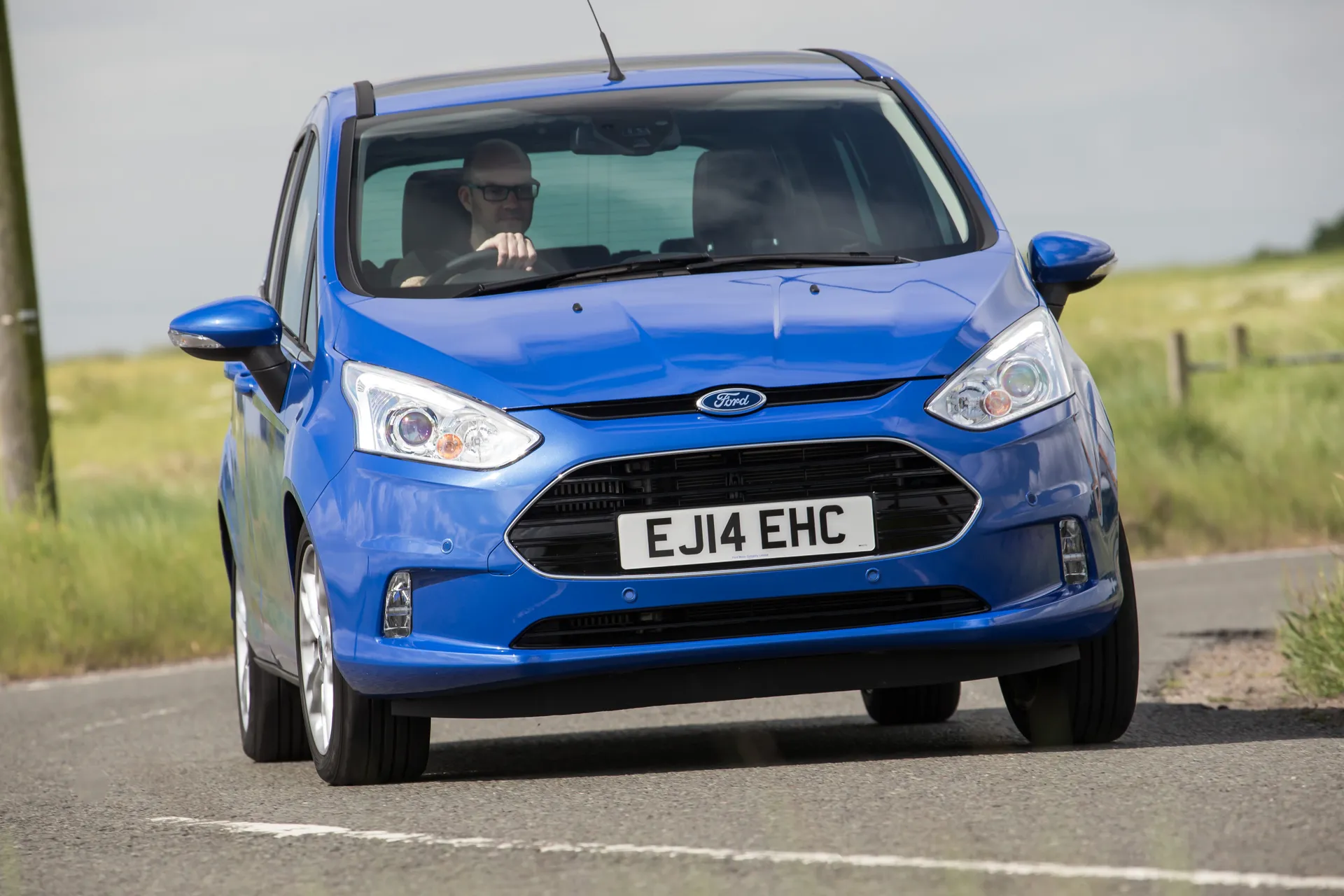
The Ford B-MAX shared its suspension with the Fiesta - which felt like it was the best-handling small car for what seemed like an eternity - and despite being taller and a bit heavier, you could feel the same kind of verve running right through it.
The steering played a big part in this. The Ford B-MAX was fitted with electric power steering rather than the older hydraulic type, and while the former was better for fuel efficiency it could make the steering feel a little lifeless in your hands. Not so with the B-MAX - you could feel the direct mechanical link to the wheels through the palm of your hands, and whether you were fully aware of it or not, that made it a nicer car to drive even if you were just shunting through a traffic jam. If you fancied taking the long way home on occasion, the Ford B-MAX was really the only car in the class that would make it worth your while.
It was the same story when it came to ride quality. There was nothing sophisticated about the Ford B-MAX’s suspension, it was very well-tuned to suit a variety of conditions. It could soak up imperfections pretty well - although it did ride a little more firmly than some key competitors of the same era - whilst resisting body roll well, something more common in taller cars like this.
What engines and gearboxes are available in the Ford B-MAX?
The Ford B-MAX has gone through a number of engine options in its lifetime, with the range slimming down as it moved towards the end of production. The basic offering was the 1.4-litre 90PS petrol, available in Studio and Zetec trims, which moved the B-MAX along reasonably well but wasn't especially quick or particularly frugal either. The bigger 1.6-litre petrol had 105PS but came with the PowerShift automatic gearbox only - it worked well enough but sapped power a little.
Two diesel engines were offered with variable outputs: 75PS and 95PS. The 75PS is best avoided. It may have had a useful 190Nm of torque but it was comfortably the slowest Ford B-MAX on sale, whereas the 95PS version offered identical fuel consumption but was usefully quicker. Neither version was particularly refined, but if you must have a diesel then the 95PS is the one to have.
We’d recommend one of the two EcoBoost petrols however. The 100PS version was as quick as the higher-power diesel, and although it couldn't match that car’s economy, it still performed well - with 55.4mpg combined (NEDC) and 109g.km of CO2. Better still, the 125PS version added stop-start as standard and was the quickest B-MAX you could buy and offered better fuel consumption than the 100PS version too.
A five-speed manual gearbox was standard on all engines (bar the 1.6-litre petrol) and offered a slick, effortless gear change. It was good enough that you wouldn't think twice about changing gear, which was exactly as it should've been.
Refinement and noise levels
If you plan to make full use of the Ford B-MAX’s ability to carry people then refinement will be an important consideration, and the compact Ford does a good job - although this is influenced by which engine you choose.
Whether you were sat up front or in the back, refinement was good for a car of this size and cost. Wind noise was kept well in check, and there was a low level of road noise filtering through to the cabin, but nothing out of the ordinary for a car like this.
The diesel engine options inevitably came with more noise and vibration than the petrol offerings, although this was more likely to bother front-seat passengers than those in the rear. The four-cylinder 1.4-litre and 1.6-litre petrols were a little quieter than the three-cylinder 1.0-litre EcoBoost offerings, but the noise the EcoBoost makes was more engaging, and the performance sacrifice wasn't worth it, especially as you had to work the bigger engines more of the time to make any progress.
Safety equipment: How safe is the Ford B-MAX?
The Ford B-MAX was tested by EuroNCAP when it was first launched back in 2012 and achieved an impressive set of results, particularly in light of the fact that the rear door design meant it had to do away with a conventional B-pillar, a big contributor to a car’s crash performance.
Euro NCAP gave the Ford B-MAX a full five-star overall rating, with a very high 92% rating for adult protection and 84% for child protection. Pedestrian mitigation was given a score of 67%, while it scored another strong result in the safety assist category with 71%.
As standard, all Ford B-MAX versions were fitted with a comprehensive suite of safety equipment, including ESP and traction control, front, side and curtain airbags, a knee airbag for the driver, and a tyre pressure monitoring system. Hill Start Assist was included on all models bar 1.4-litre petrols, and Active City Stop was a cost option, again not available on the 1.4-litre petrol. ISOFIX mounting points were fitted as standard to all models.
Safety is a consideration for everyone, but it is worth noting that the 1.4-litre models did without some useful features, which strengthens the case for choosing from higher up the range
MPG and fuel costs: What does a Ford B-MAX cost to run?
"That the worst-performing Ford B-MAX regarding fuel consumption was the 1.6-litre automatic at 44.1mpg combined (NEDC) was a good sign - this was a practical car that could still be cheap to run. The diesel options were the most economical by some margin, offering an official combined figure in excess of 70mpg (NEDC), translating to 50mpg and beyond in real-world driving."
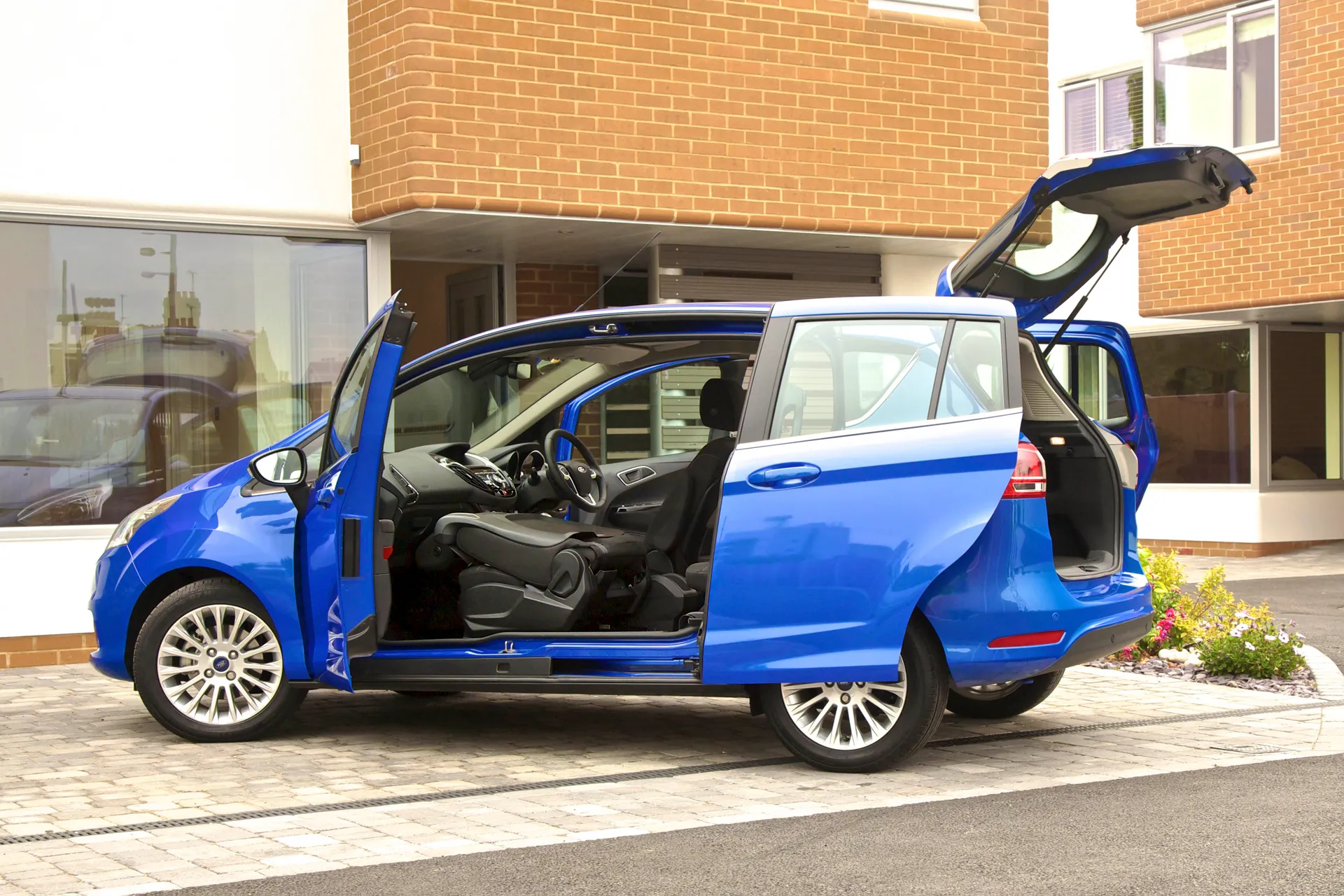
The two EcoBoost petrol options were also frugal - 55.4mpg and 57.6mpg combined for the 100PS and 125PS versions - but only if you resisted the temptation to be carried away by their enthusiasm. Thrashing them caused fuel consumption to plummet...
Ford B-MAX reliability and warranty
The Ford B-MAX has built up a good reputation here, scoring 9 out of 10 overall in previous HonestJohn.co.uk Satisfaction Indexes with buyers being impressed with its reliability. That said, there were some issues with Ford's EcoBoost engines and older PowerShift gearboxes.
Issues should've been fixed through previous ownerships, but it's worth keeping yourself right.
Ford B-MAX insurance groups and costs
As expected, the B-MAX doesn't sit in any bonkers insurance groups; there were no mega-powerful engines shoehorned underneath when it was launched (a shame really).
But for what this car is, a family MPV, insurance is cheap with 1.4 Zetec cars being the lowest in group 9. The later 1.0-litre EcoBoosts fall into group 16, but that's as far up as the numbers go regarding the B-MAX.
VED car tax: What is the annual road tax on a Ford B-MAX?
Most cars fall into the same tax bracket here, but opting for an earlier EcoBoost will save you money. The same goes for earlier 1.5 TDCi engines registered before 1 April 2017 - these are exempt as they fall short of the 100g/km c02 threshold.
The most expensive cars are the post-1 April 2017 PowerShifts, these emit 149 g/km which pushes them into Band F. Put lightly, you'll be £270 lighter for the first year, but this will drop to £190 thereafter.
Ford B-MAX price
"The B-MAX has been out of production too long to be found in pre-registered form, but you can still find late models with low mileage."
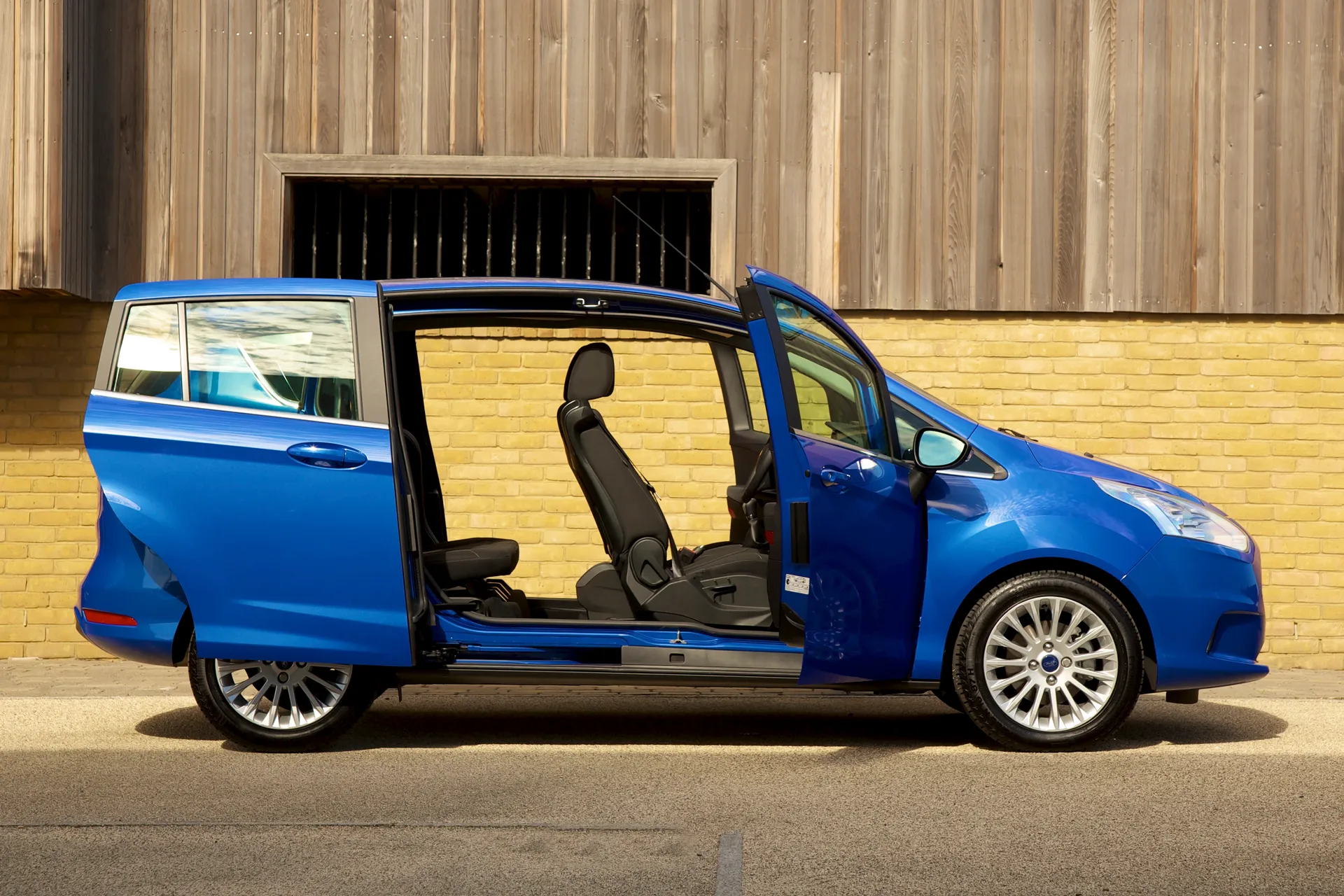
Early high-mileage cars can be had for as little as £1,500. Again, newer 2015 1.4, 1.0 petrol and 1.5 diesel cars start from £3,600.
Fancy something newer again? 2017 cars with under 10,000 miles fetch £10,000.
Trim levels and standard equipment
The Ford B-MAX Studio model launched the range. It didn't have much equipment, but it did come with some key essentials—particularly the audio system, which included DAB and Bluetooth.
When buying new, it made a lot of sense to upgrade to the Ford B-MAX Zetec model. This opened up the engine choices to include diesels, EcoBoost petrol, and automatics. Likewise, it added some desirable extras like air conditioning, the SYNC system, and the heated windscreen, which is a boon in winter.
The Ford B-MAX Titanium and Titanium X models ramped up equipment levels even further - climate control and part-leather seat trim for example - but there was little here to really justify paying the extra money. Also later models were available with Navigator specification, which added sat-nav to Zetec, Titanium and Titanium X models.
Ask the heycar experts: common questions
Is there a replacement for the Ford B-MAX?
Is the Ford B-MAX a small car?
What's the difference between the Ford B-MAX and C-MAX?
Get our latest advice, news and offers
Keep me updated by email with the latest advice, news and offers from heycar.
By submitting you agree to our privacy policy
